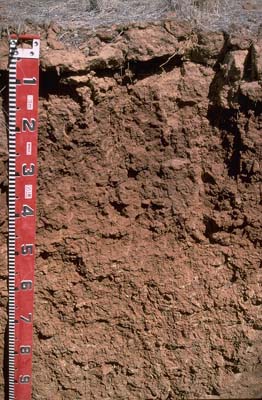LP54
| Property: LP54 Wanurp | Group: Pine Grove Farm Advance |
| Australian Soil Classification: Calcic, Mesonatric, Red SODOSOL | Northcote Factual Key: Dr 2.23 |
| Great Soil Group: red-brown earth | |
| General Landscape Description: Old alluvial plain. The original vegetation included Buloke (Casuarina luehmannii), Wallaby Grass (Danthonia spp.) and Spear Grass (Stipa spp.). This site occurs on a slightly higher position on the plain. | |
 LP54 Landscape |
Soil Profile Morphology
Surface Soil
| A1 | 0-10 cm | Yellowish red (5YR4/6); heavy fine sandy loam; hardsetting surface condition; massive; firm consistence dry; pH 6.1; clear change to: |  LP54 Profile |
| A2 | 10-15 cm | Yellowish red (5YR5/6); clay loam (fine sandy); massive; strong consistence dry; pH 6.6: | |
| Subsoil | |||
| B21 | 15-30 cm | Reddish brown (5YR4/4); medium clay; strong coarse blocky structure; strong consistence dry; pH 7.7: | |
| B22 | 30-45 cm | Strong brown (7.5YR4/6); light clay; moderate coarse blocky structure; strong consistence dry; pH 8.5: | |
| B23 | 45-70 cm | Strong brown (7.5YR5/6) and yellowish red (5YR5/6); medium clay (fine sandy); moderate medium polyhedral structure; strong consistence dry; contains some small dark segregations (possibly managnese); pH 9.2: | |
| B31 | 70 cm+ | Yellowish brown (10YR5/4) and yellowish red (5YR5/6); light clay (fine sandy); strong medium polyhedral structure (with shiny-faced peds); strong consistence dry; pH 9.1. | |
| NOTE: This soil corresponds to Koyuga Clay Loam soil of Skene and Harford (1964). | |||
Key Profile Features
- Strong texture contrast between surface (A) horizons and clay subsoil (B) horizons.
- Hardsetting surface soil (with a high fine sand content of 54%).
Key Profile Characteristics
pH | Salinity Rating | |||
Surface (A1 horizon) | slightly acid | very low | non-sodic | none1 |
Subsoil (B21 horizon) | slightly alkaline | low-medium | strongly sodic | strong |
Deeper subsoil (at 70cm) | very strongly alkaline | high | strongly sodic | strong |
| 1 Strong dispersion after remoulding. | ||||
 |
Horizon | Horizon Depth | pH (water) | EC 1:5 | NaCl | Exchangeable Cations | |||
Ca | Mg | K | Na | |||||
meq/100g | ||||||||
A1 | 0-10 | 6.1 | <0.05 | 1.4 | 1.1 | 0.5 | 0.1 | |
A2 | 10-15 | 6.6 | 0.15 | 3 | 4.5 | 0.6 | 1.4 | |
B21 | 15-30 | 7.7 | 0.37 | 0.09 | 4.8 | 6.8 | 0.7 | 3.9 |
B22 | 30-45 | 8.5 | 0.64 | 0.13 | 3.5 | 5.8 | 0.5 | 4.3 |
B23 | 45-70 | 9.2 | 0.93 | 0.16 | 3.2 | 6.2 | 0.5 | 5.6 |
B31 | 70+ | 9.1 | 1.2 | 0.21 | 3.4 | 7.7 | 0.5 | 7.2 |
Horizon | Horizon Depth | Ex Al mg/kg | Ex Ac meq/100g | Field pF2.5 | Wilting Point pF4.2 | Coarse Sand (0.2-2.0mm) | Fine Sand (0.02-0.2mm) | Silt (0.002-0.02mm) | Clay (<0.002mm) |
A1 | 0-10 | 15.4 | 5.9 | 19 | 54 | 15 | 12 | ||
A2 | 10-15 | 21.7 | 12.6 | 11 | 38 | 12 | 39 | ||
B21 | 15-30 | 31.3 | 19.2 | 8 | 29 | 10 | 53 | ||
B22 | 30-45 | ||||||||
B23 | 45-70 | ||||||||
B31 | 70+ |
Management Considerations:
- In general, management strategies for all soils should aim to increase organic matter levels in the surface soil; minimise the degradation of soil aggregates and porosity; promote the development of stable biopores; improve the calcium status of the ion exchange complex (particularly when sodium is a significant part – i.e. sodic), and break up any hardpans. Less frequent tillage; using less aggressive implements, and working the soil at optimum moisture conditions can all assist in maintaining soil aggregation and porosity as well as reducing the breakdown of organic matter. Practices such as residue retention, minimum tillage and including pasture rotations could be utilised if cropping takes place in order to build up organic matter, reduce erosion risk and increase fertility.
- Plant available water capacity (PAWC) is estimated to be low (estimated at 50 mm) for this profile - based on the laboratory data available. PAWC is limited by the strongly sodic subsoil and the high salinity (at 45 cm).
Surface (A) Horizons
- The surface horizon is hardsetting and has a high fine sand content (54%). Upon wetting and subsequent drying, the surface will set hard and will be "powdery" and difficult to work.
- The surface soil is non-sodic but will disperse when remoulded. This indicates that dispersion may occur if the soil is cultivated or over stocked in a wet condition. This could result in surface sealing and exacerbate hardsetting. Heavy rains falling on such soils when cultivated may also promote surface sealing.
- Improving surface soil organic matter levels will assist in minimising structural problems such as surface sealing as well as improving soil fertility and water holding capacity.
- Subsurface (A2) horizon disperses completely after remoulding. This would indicate that it will disperse after being cultivated in a moist condition and may form a hardpan.
- The surface horizons have a very nutrient status (based on the sum of the exchangeable basic cations).
Subsoil (B) Horizons
- The coarsely structured subsoil is strongly sodic (as well as having a low calcium: magnesium ratio of 0.7) and disperses strongly in water. This is likely to result in water and root movement being restricted.
Comments from Landholder:
- Not cropped since the early 1970's.
- Gypsum has not been used here.


